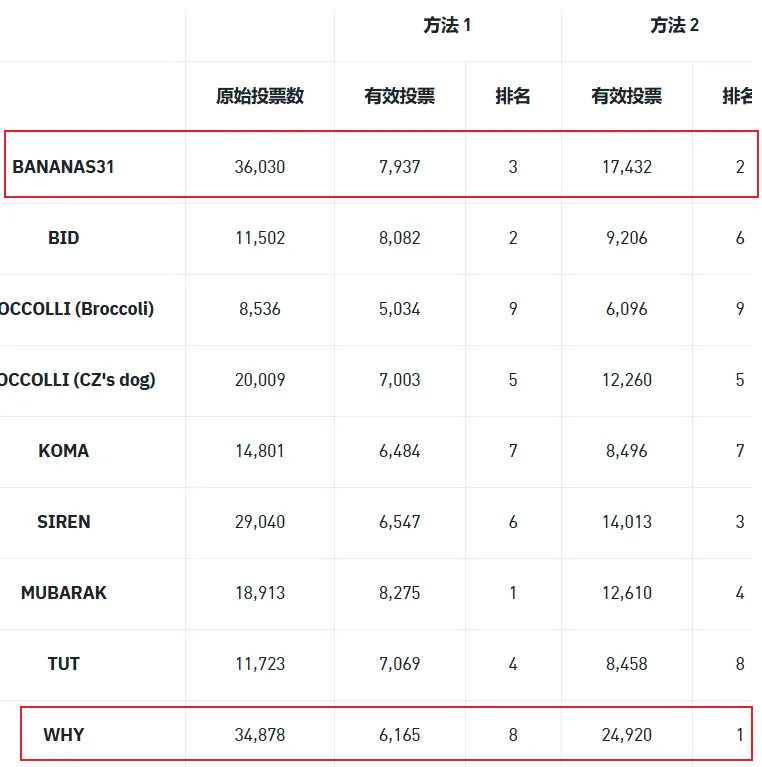Today, Binance launched 4 tokens, marking the beginning of a new listing strategy for Binance. This represents a completely new path for a large number of MeMe or project teams. Let's analyze this from the data perspective.
- Community Voting Data Analysis
From the final results, the total number of votes was 185K, with a total of 119K participants. Since each person had 5 votes, the actual average number of votes cast per person was only 1.5.
Binance's first step was to exclude invalid votes, which included the following 4 situations:
1) Fraudulent activities (e.g., fake accounts, deceptive behavior)
2) Bulk operations (fake voting through IP/device mining)
3) Exploitative behavior (tampering with Binance's code, system, or API)
4) Illegal/harmful behavior (fraud, scams, or malicious activities to attract votes)
So, how many invalid votes were excluded? 12K, which accounted for only 6% of the total votes. This indicates that Binance's exclusion of fraudulent activities only removed 6%.
Now, here comes the interesting part.
The second step was to exclude votes from users who did not hold at least 0.01 BNB.
Because on the voting page, there was a very prominent reminder that users needed to hold 0.01 BNB during the voting period. In fact, 0.01 BNB is worth about $6, which is not a significant requirement for ordinary users.
However, it was found that a large number of votes were deemed invalid due to the 0.01 BNB holding requirement. According to the results published by Binance, there were two methods:
Method 1: Hold 0.01 BNB for the entire duration of the activity.
According to the rules written on the voting page, it was required that the account must hold 0.01 BNB throughout the voting period, so the statistics from Method 1 were compliant. However, the results from Method 1 were quite dismal, with only 62K valid votes, which is only 33% of the original. This means that while Binance excluded votes from fraudulent bulk operations, it only removed 6%. Yet, the small requirement of 0.01 BNB led to the exclusion of 67% of the voting numbers.
After excluding invalid votes, the vote counts were arranged as follows:
MUBARAK: 8,275
BID: 8,082
BANANAS31: 7,937
TUT: 7,069
BROCCOLLI (CZ's dog): 7,003
SIREN: 6,547
KOMA: 6,484
WHY: 6,165
BROCCOLLI (Broccoli): 5,034
We can see that the 4 projects listed on Binance are among the top 5, meaning that according to the voting rankings, all except BID were listed.
It seems that Binance noticed too many invalid votes and then calculated Method 2. Method 2 counts from the moment the vote is cast, requiring the user to hold 0.01 BNB. The scenario for Method 2 is that if a user did not have BNB in their account initially, they would realize the requirement when voting and then purchase it. However, even in this case, the valid votes were still only 113K, excluding 35%.
The rankings from Method 2 differ significantly from Method 1, and the final listings also show considerable variation from Method 2's rankings. Therefore, Binance likely used the BNB holding method announced to determine part of the listing decisions.
- Binance Alpha and Binance Contract Market Transaction Volumes
These two transaction volume data points represent the genuine intentions of users. Including this metric can effectively prevent purely fraudulent voting based on headcount, as the cost of headcount is not high. The following chart shows the transaction volume for Binance Alpha, which clearly explains why BID was not selected. Its trading volume is significantly lower than the others. Similarly, the name "Why" had the second-highest number of votes, but its transaction volume on Alpha was only 879K, which is very low. KOMA's trading volume was also relatively low.
If we also analyze the transaction volume in the Binance contract market, we can reach similar conclusions. As of the 27th, the transaction volumes were: MUBARAK at 350 million, BANANAS31 at 140 million, TUT at 70 million, BID at 17.58 million, and BROCCOLLI (CZ's dog) at 30 million.
- Announced Evaluation Criteria
Let's take a look at the comprehensive evaluation criteria published by Binance:
1) Results of the community voting activity (natural votes after excluding spam activities; details below)
2) Historical performance of the token
3) Trading demand, especially the trading volume in the Binance contract market and Binance Alpha platform
4) Fundamental analysis
5) Compliance checks
6) Risk assessment
Although there are 6 criteria, the fourth, fifth, and sixth criteria should be the same for all MeMe. Therefore, we are left with 1, 2, and 3. The first and third criteria are relatively easy to quantify with data. From the results, the effective votes from the community had a significant impact on the final listings.
- Summary:
1) From the data, it can be seen that in this voting launch by Binance, the weight of community voting is quite significant. Essentially, 4 out of the top 5 valid votes were listed. The reason BID was not listed is primarily due to the low trading volume on Binance Alpha and the contract market.
2) However, a large number of votes became invalid during the voting process. One of the requirements was that users needed to hold at least 0.01 BNB during the voting activity. While this setting may exclude some genuine users, it is also very effective in preventing cheating and vote manipulation, as project teams might spend money to ultimately buy invalid votes.
3) For genuine community members, if considering future token listings, it is recommended to hold at least 0.01 BNB in their accounts.


免责声明:本文章仅代表作者个人观点,不代表本平台的立场和观点。本文章仅供信息分享,不构成对任何人的任何投资建议。用户与作者之间的任何争议,与本平台无关。如网页中刊载的文章或图片涉及侵权,请提供相关的权利证明和身份证明发送邮件到support@aicoin.com,本平台相关工作人员将会进行核查。




